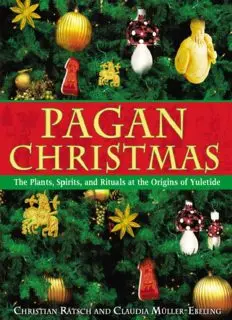
Pagan Christmas: The Plants, Spirits, and Rituals at the Origins of Yuletide PDF
Preview Pagan Christmas: The Plants, Spirits, and Rituals at the Origins of Yuletide
PAGAN CHRISTMAS The Plants, Spirits, and Rituals at the Origins of Yuletide Christian Rätsch and Claudia Müller-Ebeling Translated from the German by Katja Lueders and Rafael Lorenzo Inner Traditions Rochester, Vermont CONTENTS Preface The Ethnobotany of Christmas Traditions, Rituals, and Customs Christmas Songs of the Hard Winter A Pagan Feast Red and White: Colors of Christmas The Darkness of Midwinter Sacred Nights, Smudging Nights, and Incense Wotan and the Wild Hunt From the Shamanic World Tree to the Christmas Tree Christmas Trees Holy Trees St. Nicholas and His Little Helper, Ruprecht Baccy Claus: The Smoking Christmas Man Father Christmas: An Anthropomorphic Fly Agaric Mushroom? Christmas Tree Decorations The Golden Apples Miracle Blossoms for the Winter Solstice St. Barbara’s Boughs Christ Rose or Hellebore Christmas Roses Christmas Stars Exotic Christmas Flowers Christmas Greens The Old Ones of the Woods Mistletoe: Winter Woods Green Holly: Frau Holle’s Holy Tree Laurel: The Sun God’s Plant Ivy: Tendrils of the Maenads The Aromas of Christmas: A Shower of Pheromones Incense for the Holy Nights Incense Under the Christmas Tree Incense Recipes for the Smudging Nights Christmas Intoxications and Other Delights Yule Drinking Love on Christmas Eve? Chocolate Father Christmas: Ritual Christmas Cannibalism Mugwort, the Sacrificial Goose, and the Christmas Roast Rosemary and the Yule Boar Merry Christmas from Mother Coca, Coca-Cola, and Santa Claus Christmas Spices and Christmas Baking Anise and St. Andrew’s Night Saffron: Red Gold for Christmas Christmas Baking The Rebirth of the Sun Sun Gods: Apollo, Mithras, and Jesus Mystery Cults Kyphi: Incense for the Smudging Nights Saturn, the God of Incense The Erotic Bean Feast New Year’s Eve: The Wild Feast of Sylvester Protection and Fertility Rites Lucky Plants Happy New Year Thunder and Witch Flour From Incense to Fireworks Lucky Mushrooms and Chimney Sweeps New Year’s Day Magical, Shamanic Clover The Night of Befana, the Christmas Witch Holy Bushes that Protect Against Witches Paradise Plant Devil’s Dirt and Witches’ Smoke Three Kings Day: The End of the Christmas Season The Pagan Magi from the East Frankincense, the Secret of Old Arabia Footnotes Bibliography Also by Christian Rätsch and Claudia Müller-Ebeling About the Author About Inner Traditions Books of Related Interest Copyright FOR OUR FAMILY PREFACE We celebrate Christmas in the middle of winter, when the trees are bare and nothing in our gloomy, gray and white surroundings reminds us of the vivid green landscape of summer. Each year at Christmastime, we participate in a kind of ritual “summerfest” involving evergreen branches and winter-blooming plants, during the heart of the cold, dark winter season. Why? The simple answer is because it is exactly at this time of year that we yearn most strongly for green plants, blossoms, and the light of the sun. During the harsh winters of the past, our ancestors felt the same longing. This book is about the ethnobotany of Christmas—a study of Christmas plants and their symbolic uses and meanings throughout the centuries. Looking at it in the glowing light of the candles in the Advent wreath and the festively lit Christmas tree, it is easy to see that plants contribute much to this feast season. During the dark time of Advent, we especially appreciate having a green fir tree and blooming plants in the house, such as poinsettia and Christmas cactus. We hang mistletoe and decorate our doors with wreaths made from fir, ivy, and holly. For roasts and baking, we use exotic spices from trees, shrubs, and plants of tropical regions. The children wait excitedly for St. Nicholas, Father Christmas, or Santa Claus, for whom they put out shoes, stockings, and gift plates, expecting marzipan, chocolate, apples, tangerines, and nuts in return. Many of these delights come from trees in warm, faraway regions from which we import their fruits. Christmas is the most culturally pervasive and successful feast of all time. But what is behind our treasured Christmas traditions and customs? Why do green fir branches, flowers that bloom in the middle of the winter, Christmas spices, and incense still play such a central role in Christmas celebrations around the world? What are the symbolic meanings behind the use of these plants, and how have the old customs survived into the present computer age?
